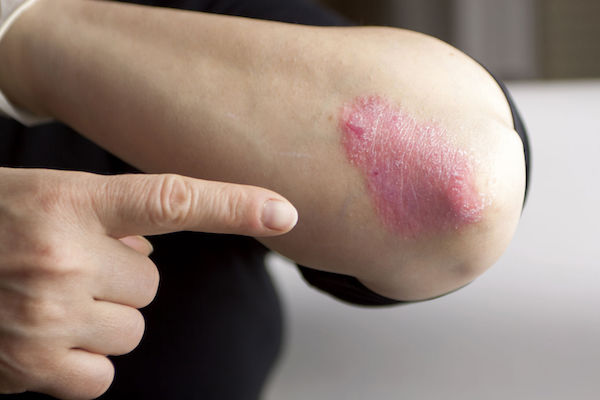Psoriasis is a chronic, inflammatory skin disease in which skin cells build up and form scales and itchy, dry patches.

While the exact cause of psoriasis is not known, it occurs when the skin regeneration process accelerates. Skin cells are usually replaced every three to four weeks but in people with psoriasis, it takes about three to seven days.
Immature cells build up rapidly on the surface of the skin, causing red, flaky, crusty patches covered with silvery scales.
There are several different types of psoriasis. These include:
- Psoriasis vulgaris (common plaque type)
- Guttate psoriasis (small, drop-like spots)
- Inverse psoriasis (present in folds such as underarms, navel, groin, and buttocks)
- Pustular psoriasis (small pus-filled yellowish blisters).
Risk factors of psoriasis include:
- Genetic (family history of the condition)
- Viral or bacterial infection
- Obesity
- Smoking
- Acute stress
- Use of certain medications.
What are its symptoms?
Psoriasis symptoms vary from person to person and depend on what type you have.
They may include one or more of the following:
- Red patches of skin covered with silvery scales on face, scalp and body
- Small scaling spots
- Dry, cracked skin that may bleed
- Itching, burning or soreness
- Thickened, pitted or ridged nails
- Swollen and stiff joints.
Some people have mild psoriasis (small, faint dry skin patches), while others have a severe case where their entire body is covered with red, scaly skin.
Most types of psoriasis go through cycles, flaring for a few weeks or months, then subsiding for a time or even going into remission.
How is it diagnosed?
A psoriasis diagnosis is typically made by obtaining information from the physical examination of the skin, scalp and nails, your medical history and relevant family history.
In some cases, your doctor may take a small sample of skin (biopsy), which is examined under a microscope to determine the exact type of psoriasis and to rule out other disorders.
Sometimes an X-ray may be necessary when psoriatic arthritis is suspected.
What are your treatment options?
There is no cure for psoriasis but there are many effective treatments. Your doctor will advise the most suitable one based on the psoriasis you have, its location, severity, your age and overall health.
The purpose of treatment is to slow the rapid growth of skin cells that causes psoriasis and to reduce inflammation.
Most cases are mild and can be treated with:
- Cream, ointment and lotions to moisturise the skin
- Shampoos, oils and sprays to treat psoriasis of the scalp
- Exposure to sunlight
If your condition is more severe, treatment may also include:
- Prescribed skin products
- Prescribed pills
- Injections to boost your immune system
- Light therapy, which involves exposing your skin to a special ultraviolet light.
Can it be prevented?
There is no way to prevent psoriasis. But these home treatments may improve symptoms or help reduce the number of flare-ups:
- Moisturising care for skin, scalp and nails
- Try some of the many psoriasis creams, ointments and shampoos you can buy without a prescription
- Follow your schedule for sunlight or ultraviolet light treatments
- Be aware of possible medicine reactions
- Alcohol use can cause symptoms to flare up. Limit your daily intake.
- Studies haven’t found any 'psoriasis diet' that can cure or improve the condition. Try to eat a balanced diet and stay at a healthy weight.
Avoid triggers such as smoking, infection, scratching your skin or acute stress. A study by the National Psoriasis Foundation in the US found that patients with psoriasis have a 39 percent increased risk of depression, a 31 percent increased risk of anxiety and a 44 percent increased risk of suicide.
For more info
The South African Psoriasis Association (SAPSA)
IMAGE CREDIT: 123rf.com
